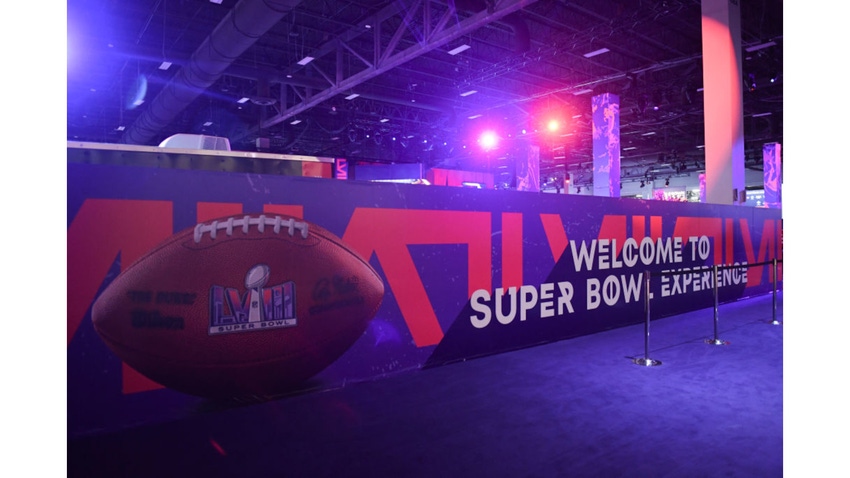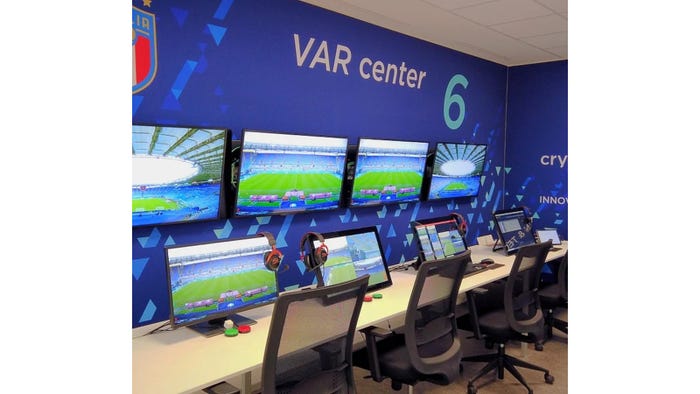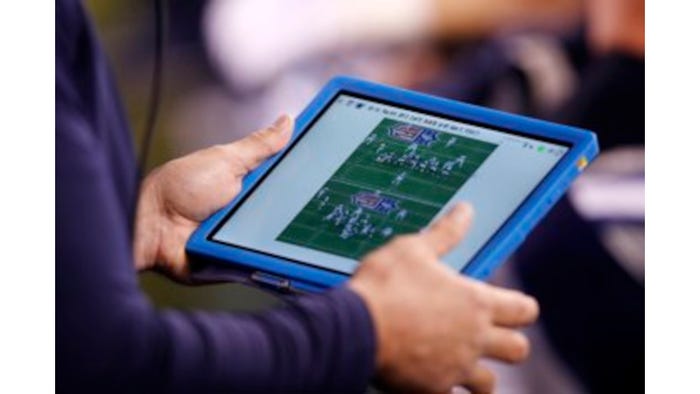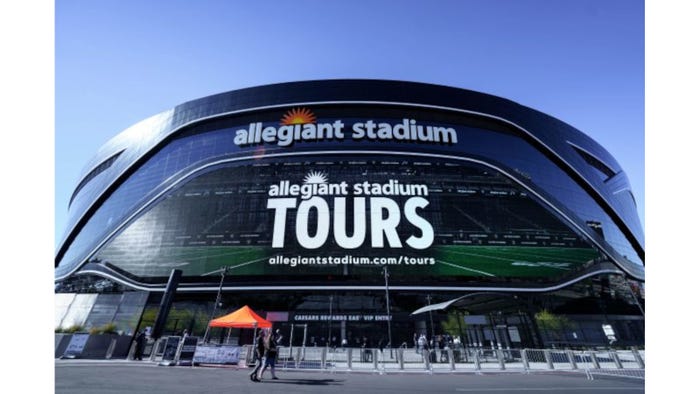Super Bowl 2024 Scores Rout for Tech
One of the world’s largest sporting events is a showcase for the latest tech advancements.

At a Glance
- Technology continues to score big at the Super Bowl
- Advanced video tech is all over the stadium and helping settle calls that come under question.
- AI and data analytics are helping to shape strategy and rosters.
In two days, the San Francisco 49ers will meet the Kansas City Chiefs in Super Bowl 58. While there are all kinds of predictions on who will win the game and what the score will be, one certain thing is that the technology used during the telecast and live at the game will go beyond what was used last year, and far exceed the ancient technology used in the early days when no one envisioned how big an event this would become.
Display technology, WiFi connectivity, advanced cameras, and safer helmets are just some areas where innovations will abound. Data analytics, increasingly aided by artificial intelligence (AI), is a key tool in collecting and analyzing the data that is helping to make some of these advancements possible.
Some of the more significant technologies, both on full display and behind the scenes, are detailed below.
Protecting the Valuable Assets: Players
When Kansas City Chiefs quarterback Patrick Mahomes recently shattered his helmet in the cold weather but didn’t get seriously injured, it was a testament to the numerous advancements in football gear over the years and the attention being paid to player safety. According to a blog post on Inclusioncloud.com, companies such as Riddel have been instrumental in promoting safer football helmet technology. Riddel has been partnering with the National Football League on helmets for years, with products such as its SpeedFlex Diamond Series helmet which employs leading technologies such as robotics and 3D printing.
The same article called attention to another device aimed at player safety, called the Q-Collar, which is a lightweight necklace-like device that reportedly limits brain movement during impacts to reduce brain injuries.
Did the Player Cross the Goal Line?
According to several reports, the first Super Bowl in 1967 had no more than 12 cameras. That number has grown by leaps and bounds, with cameras capturing game action and sideline activities from many angles.
A major focus is of course capturing crucial plays at various speeds and angles. For the past three years, Hawk-Eye Innovations has had its innovative Synchronized Multi-Angle Replay Technology (SMART) system deployed at NFL games to lend its discerning eyes to capture different perspectives of play. The benefit is elevating game officiating, though ardent football fans may still argue that. This year, Hawk-Eye has introduced goal-line cameras that can determine whether the ball has completely crossed the goal line. Cameras are positioned to the left and right of the goal line to register the action there.

SmartEye Innovations Hawk-Eye replay system is taking the guesswork out of tough play action decisions.
The Play is Coming Through the Headset
Radiofrequency ID is not only for tracking inventory in a store or product in a manufacturing line. RFID is omnipresent in football, with tags RFID embedded in players’ helmets and shoulder pads as well as in footballs themselves. Football stadiums have RFID receivers strategically located throughout to pick up the data from RFID tags. These tags provide a wealth of information including player positioning, ball dynamics, and other information crucial for on-the-fly decisions.
Zebra Technologies, a provider of business solutions that employ RFID, has since 2015 partnered with the NFL on using RFID to track both player and ball movement, capturing real-time data such as speed, acceleration, and distance covered. This information provides valuable insights into player performance, enabling teams and coaches to make data-driven decisions and optimize strategies.
In addition, advanced radio and other digital communication systems are enabling coaches to relay plays to quarterbacks within seconds, lessening the need for cryptic armbands with play information.
Tablets Show the Costly Interception
You may have seen players viewing tablets after plays after a costly fumble or interception. Since 2014, all NFL teams have had access to specially configured Microsoft Surface tablets as part of the Sideling Viewing System, which provides clear color images of plays in real-time. This system replaced the grainy black-and-white images from instant cameras used for years and enables coaches and players to review plays so on-the-fly play adjustments instantly can be made. The tablets are designed to withstand rugged outdoor use─including being dropped by disgusted players or coaches and connecting to a stadium’s data transmission network to reliably transmit data.

Microsoft Surface tablets are giving both coaches and players instant feedback on plays.
The Super Viewing Experience
Last year’s Super Bowl, 57 was the first to broadcast in 4K video technology. As the race for bigger and better TVs to watch the big game continues, giant 4K flat-panel TVs sporting technologies such as QLED and OLED are being snatched up by consumers everywhere, not only for the Super Bowl but also for viewing movies and other events.
But such TVs pale compared to the video displays at Allegiant Stadium where Super Bowl 58 is taking place. Korean consumer electronics giant Samsung has outfitted one of the league’s newest football venues with over 66,000 feet of LED displays totaling over 93 million pixels. This includes three video boards installed in the end zones, score clocks, and ribbon boards, which border the 200- and 300-levels in the main seating bowl. But the coup de grace is the 27,600-square-foot Samsung outdoor LED mesh display positioned on the exterior of the building—said to be the largest outdoor stadium marquee in professional football.

One of Samsung's LED displays at Allegiant Stadium.
Cisco Helps Keep Out Hackers
For the past two years, network security giant Cisco partnered with the NFL to provide an all-encompassing security architecture that combines both on-premises hardware and cloud-based software. According to Cisco, the solutions protect against phishing, malware, and ransomware, while also providing vital threat intelligence and end-to-end network visibility. According to inclusioncloud.com, at last year’s Super Bowl, Cisco identified, analyzed, and triaged nearly 9,000 intrusion events, blocked more than 400,000 connections from blocklisted regions, and blocked almost 17,000 security intelligence events.
Text and Bet Anywhere
Not surprisingly, WiFi networks are an essential element at sporting events for the fan experience, stadium operations, and the participating teams. Allegiant Stadium, home of the Las Vegas Raiders and site of this year’s Super Bowl, has had a massive WiFi network from its inception in 2020. But last year, the stadium received enhanced wireless service through a Distributed Antenna System that enables calls, texts, and downloads from inside the facility. The stadium is already covered by over 1,700 managed WiFi access points and redundant 40-gigabit optical Internet connections.
Allegiant Stadium has also partnered with MatSing, a provider of lens antennas for mobile connectivity, to provide 14 additional lens antennas throughout the venue to improve mobile connectivity. According to MatSing, these antennas will enable fans to experience lighting-fast mobile connectivity with few interruptions as they use their phones to place bets, upload content to their social media channels, or even order food from stadium vendors during the game.
Trusting the Gut or Computer
With the help of AI, data analytics has become a key part of football, not only the Super Bowl. Football teams tabulate and evaluate stats on a team’s players as well as the opposition. They use advanced statistics and machine-learning algorithms to analyze player performance, opponent tendencies, and game situations. This data-driven approach influences decisions on play-calling, player drafting, and game planning. While decisions are still made on what is termed “gut instinct,” nowadays a computer is least equally likely to have its say in a game or planning decision.
For football fans, data analytics plays a role in wagering and betting.
Wagering By Tapping the Phone
Mobile apps are now available to cover most facets of the football game experience. These include viewing apps that broadcast the game, other sports apps with all types of game information, and perhaps most notably, sports betting apps for those wishing to wager on the game. The Super Bowl is a cash king for sports betting apps.
About the Author(s)
You May Also Like



.jpg?width=300&auto=webp&quality=80&disable=upscale)

